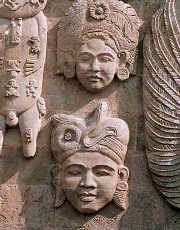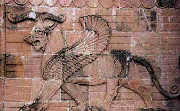 Mural painting art, a combination of architecture and fine arts, has infinite charm.
Mural painting art, a combination of architecture and fine arts, has infinite charm.
During the art form's development, it experienced a period of resplendence before gradually declining. However, with the development of architecture, the mural painting is slowly making a comeback. The mural painting, which has been applied in construction frequently, is paid great attention to and accepted by most people.
 The content of the mural painting
The content of the mural painting
The mural painting's content in the primeval period mainly reflected real life, such as hunting, grazing, planting, domestic animals, houses, dance, festivals, totems, and even witchcraft. It is said that heroic figures and historical stories appeared in the mural paintings as early as the time of the Yellow Emperor (Huang Di) and theXia Dynasty(c.21st-c.16 century BC). Figures of Yao and Shun, both known as benevolent mythical Chinese rulers, and Jie, the atrocious emperor of the Xia Dynasty were painted with for propaganda and educational purposes.
painted with for propaganda and educational purposes.
The main mural painting artworks of theHan Dynasty(206BC-220AD) were later exvacated from the grave, which also reflected real life, historical figures and stories and fairy tales.
The content scope of modern mural painting, which often reflect the flavor of the ethic customs, splendid mountains and rivers, human civilization and science and technology apart from the traditional themes like historical figures and stories is larger than the traditional one.
 The composition of mural paintings
The composition of mural paintings
The composition of the Han Dynasty's carved stone mural paintings were not restricted by the space-time For example, the "war", unearthed in Yinan County in East China'sShandong Province, portrays the picture of the war incisively and vividly. The bridge is the main axis in the picture. On the right of the bridge is the leader driving the carriage and on the left is the fighting scene. Under the bridge there are marines boating in the river.